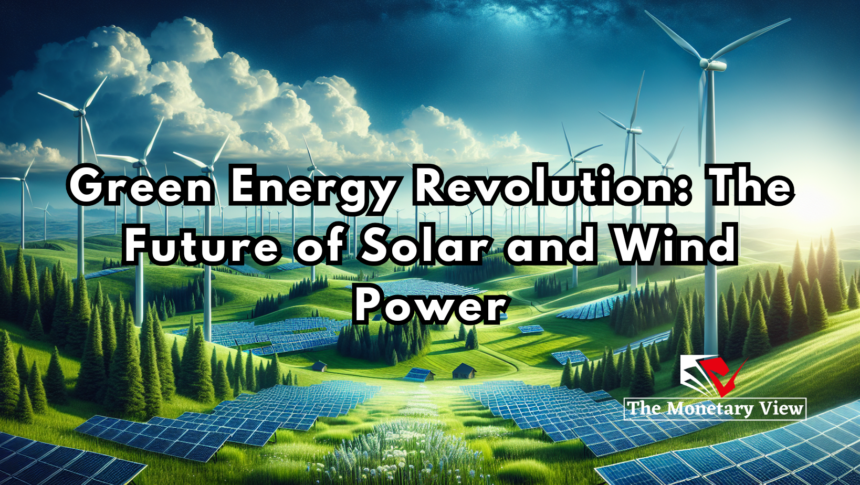As the world increasingly faces the effects of climate change and the depletion of fossil fuel reserves, green energy has emerged as a critical solution to provide sustainable, clean, and renewable power. Among the various sources of green energy, solar and wind power stand out as the most promising due to their abundance and potential to significantly reduce carbon emissions. This green energy revolution is reshaping industries, creating new jobs, and offering a cleaner future for the planet.
In this article, we will explore the evolution of solar and wind power, the benefits and challenges they bring, and what the future holds for these energy sources.
1. What is the Green Energy Revolution?
The green energy revolution is a global shift towards renewable energy sources such as solar, wind, hydro, and geothermal to power our homes, industries, and transportation. The revolution aims to reduce greenhouse gas emissions, decrease dependency on fossil fuels, and promote sustainable energy sources. Solar and wind energy play a central role in this revolution, as both can be harnessed on a large scale and are readily available in most regions.
2. Solar Power: Harnessing Energy from the Sun
Solar power involves capturing sunlight and converting it into electricity using solar panels or photovoltaic (PV) cells. The technology has evolved dramatically over the past few decades, making it more efficient and affordable.
How Solar Panels Work
Solar panels consist of many photovoltaic cells, typically made of silicon. When sunlight hits these cells, it excites electrons, creating an electric current that can then be used to power homes, buildings, or stored in batteries. Solar energy can also be used to generate thermal energy for heating.
Advantages of Solar Power
- Abundant and Renewable: Sunlight is abundant, especially in equatorial and sunny regions, and can be harnessed daily.
- Reduces Electricity Bills: Installing solar panels can significantly reduce electricity costs by generating power onsite.
- Low Environmental Impact: Solar power produces no emissions, making it an environmentally friendly energy source.
- Minimal Maintenance: Solar systems typically require minimal upkeep, making them a long-term solution for energy needs.
Challenges of Solar Power
- Intermittency: Solar energy generation depends on sunlight, making it less reliable during cloudy days or at night.
- Energy Storage: Batteries are needed to store excess energy for later use, and they can be costly.
- High Initial Costs: While prices are decreasing, the initial installation of solar panels and related equipment can still be expensive.
3. Wind Power: Capturing Energy from the Wind
Wind power involves converting wind energy into electricity using turbines. As the wind turns the blades of a turbine, it spins a generator that produces electricity. Wind energy is one of the fastest-growing renewable sources and is increasingly used in both onshore and offshore wind farms.
How Wind Turbines Work
Wind turbines consist of large blades attached to a rotor, which is connected to a generator. When wind blows across the blades, it creates lift (similar to an airplane wing), causing the rotor to spin and generate electricity.
Advantages of Wind Power
- High Energy Output: Wind turbines, especially those offshore, can produce a significant amount of electricity.
- Cost-Effective: Wind energy has become one of the cheapest forms of electricity generation, thanks to advances in technology.
- Scalability: Wind farms can be set up on land (onshore) or at sea (offshore), providing flexibility based on location.
- Environmentally Friendly: Wind power generates no emissions and has a low carbon footprint.
Challenges of Wind Power
- Intermittency: Like solar, wind is inconsistent, and power generation depends on wind speed and availability.
- Impact on Wildlife: Wind turbines can affect bird and bat populations, raising environmental concerns.
- Noise and Visual Impact: Large wind farms, especially onshore, may create noise and visual pollution that some communities find undesirable.
4. The Role of Technology in Solar and Wind Power
Advancements in technology are essential for maximizing the potential of solar and wind energy. Here are some of the most promising developments:
- Energy Storage Solutions: High-capacity lithium-ion batteries and other advanced storage solutions allow excess energy generated during sunny or windy periods to be stored for later use.
- Smart Grids: Smart grids integrate renewable energy into the power system, balancing supply and demand while reducing waste.
- Floating Solar Farms: To maximize space, some regions are installing floating solar panels on bodies of water.
- Offshore Wind Farms: Offshore wind farms take advantage of stronger, more consistent winds at sea and have less impact on populated areas.
- Energy Efficiency: Advances in PV cell technology are making solar panels more efficient, allowing them to convert a greater percentage of sunlight into electricity.
5. Environmental and Economic Benefits
The green energy revolution offers both environmental and economic benefits, making it an attractive solution for governments, industries, and consumers.
- Reduction in Greenhouse Gas Emissions: Solar and wind power are clean sources of energy that emit no greenhouse gases, helping to combat climate change.
- Job Creation: The renewable energy sector has created millions of jobs globally in solar and wind installation, maintenance, research, and development.
- Energy Independence: By investing in renewable energy, countries can reduce their dependence on imported fossil fuels, which strengthens energy security.
- Cost Savings: As technology advances and economies of scale increase, the cost of solar and wind power continues to drop, providing affordable energy for consumers.
6. The Future of Solar and Wind Power
The future of solar and wind energy is bright, with rapid advancements and increasing adoption across the globe. Some trends to look out for include:
- Grid Parity: In many regions, the cost of solar and wind energy is now on par or even lower than traditional fossil fuels, making them competitive alternatives.
- Hybrid Power Systems: Combining solar, wind, and battery storage into hybrid systems can address the intermittency issue, providing a steady and reliable power source.
- Policy Support: Many governments are enacting policies and incentives to support renewable energy, such as tax breaks, subsidies, and clean energy targets, further accelerating adoption.
- Research and Innovation: Ongoing research aims to improve the efficiency of solar cells and wind turbines, while new technologies like perovskite solar cells and vertical-axis wind turbines hold promise for the future.
Conclusion
The green energy revolution driven by solar and wind power is paving the way for a cleaner, more sustainable future. While challenges such as intermittency and initial costs remain, ongoing technological advancements and policy support are making renewable energy more accessible and affordable. As we transition away from fossil fuels, solar and wind energy will play a crucial role in achieving global sustainability goals and combating climate change. With innovation and investment, the future of renewable energy is bright and holds the potential to transform our world.







